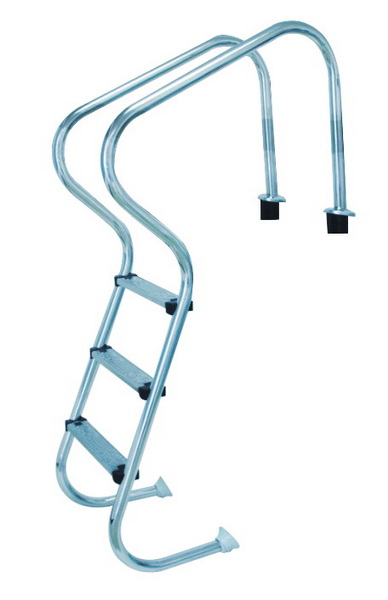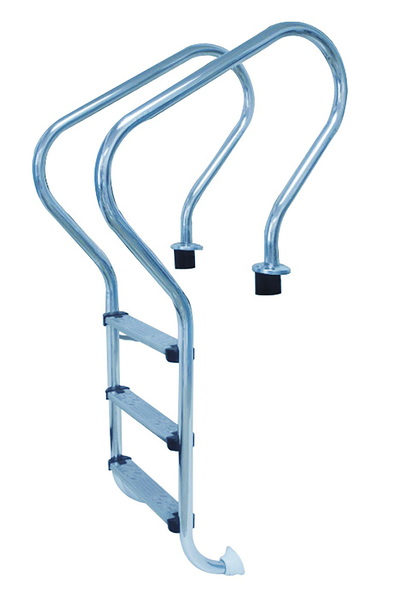Views: 222 Author: Tina Publish Time: 2025-10-08 Origin: Site








Content Menu
● Understanding Pool Ladder Types
● Safety Standards and Best Practices
● Step-by-Step Ladder Adjustment
>> Adjusting Height and Stability
>> Troubleshooting Common Issues
● Choosing Durable, Comfortable Ladders
● Advanced Stability and Safety Enhancement
>> 1. Why does my above ground pool ladder wobble?
>> 2. How to raise a ladder that's too short for my pool wall?
>> 3. Can I anchor the ladder directly to my deck?
>> 4. What ladder material is most durable?
>> 5. Should I remove the ladder for pool closing?
Properly adjusting and maintaining an above ground pool ladder is essential for safe, convenient, and long-lasting pool access—especially for families and international pool owners seeking reliable, OEM-certified quality. This comprehensive guide explains every practical step, addresses common challenges, shows how to enhance ladder stability, safety and longevity, and answers essential questions, all supported by curated visuals and referenced manufacturer standards.

Above ground pool ladders come in several designs tailored to different pool layouts and needs:
- A-Frame Ladder: Freestanding, no deck required, typically for round or oval pools.[1]
- Deck Mounted Ladder: Bolted securely to a surrounding deck, offers improved safety and convenience.[2]
- Pool Steps: Wall-mounted, offer spacious and safer access, especially suited for deep pools or elderly swimmers.[3]
- Heavy-Duty Models: Designed for larger or commercial pools, featuring reinforced handrails and anti-slip steps.[1]
Improperly adjusted ladders pose serious risks:
- Wobbling: Can cause falls or injuries, especially for children and seniors.[4]
- Incorrect Height: A ladder too short or tall makes entry difficult and unsafe, and may damage the liner.[5][1]
- Weight Distribution Issues: An unstable base or loose bolts increase accident risks.[4]
- Accessibility: Convenient, safe ladders encourage use and ensure all swimmers feel confident entering or exiting the pool.[6]
Industry recommendations from the CPSC and pool ladder manufacturers include:
- Steps should be at least 3 inches wide and covered in a non-slip material.[6]
- Ladders must have handrails on both sides, easily gripped by children.[6]
- All sharp edges and protruding bolts should be covered.[6]
- Ladders should be restricted or removed when not in use—locking mechanisms or removable designs are recommended.[7][6]
- When mounting to decks, use dedicated brackets and ensure all fasteners are corrosion-resistant.[2]
To assemble and maintain your pool ladder, gather:
- Power drill
- Screwdrivers of various sizes
- 4-foot level
- Silicone sealant
- Stainless steel fasteners (bolts, washers, nuts)
- Pool noodles, foam pads, sandbags, zip ties (for stability)
- Non-abrasive cleaner, soft brush, and water for cleaning[8][9]
- Teflon tape (for foam support wrapping)
- Pool ladder owner's manual
- Read the owner's manual. Compare your pool's height with the ladder's specifications. Most above ground pools range from 48 to 54 inches tall—choose or adjust your ladder to match this.[5][1]
- Lay out all ladder parts as labeled, distinguishing rails, steps, and support braces.
- Attach the steps to the rails, matching all labeled sections and securing with bolts.
- Be careful not to overtighten, especially with nylon nuts; snug each bolt for stability.
- Place the ladder where intended, ensuring bottom rails sit evenly on firm ground.
- If your ladder is too short, use supportive foam pool noodles, yoga mats, or rigid pads under the legs.[1][5]
- For adjustable models, set the telescoping legs at the correct position and lock them per the manual's instructions.[12]
- Make sure the ladder stands firm and does not flex under maximum weight (at least 300 lbs recommended for commercial durability).[1]
- For A-frame ladders: Fill legs with water or sand to add weight and improve stability—seal fill holes as directed.[12]
- For deck mounted models: Use stainless steel brackets and bolts to anchor the ladder firmly. If the deck is raised above pool edge, a custom step platform can ease entry.[2]
- Always check for loose parts after securing and ensure no sharp ends are exposed.
- Place a long level across all ladder rails and steps, checking for even contact on every point.[4]
- Use foam or pool noodles under unbalanced legs, or a wood platform for uneven ground or decks.[2]
- Secure supports with zip ties or weatherproof tape to prevent movement.
- Wobbling: Tighten all bolts; adjust supports; use sandbags or foam to anchor legs.[4]
- Short Ladders: Add risers, foam mats, or swap for taller adjustable ladders.[1]
- Slippery Steps: Install anti-slip tape or step covers on all platforms.[6]
- Corrosion or Rust: Replace with stainless steel or resin parts; apply silicone sealant.[8]
- Damaged Ladder Tubing: Use repair plugs hammered into the tube ends as a quick fix.[13]
Deck-mounted ladder upgrades enhance convenience and safety for pool owners with decks:
- Select a model rated for deck installation with reinforced mounting hardware.[2]
- For uneven deck-to-pool transitions (where the deck is above the pool edge), build a step platform using treated wood to bridge the gap.[2]
- Always mount on a solid surface, and avoid placing ladders directly where water collects to prevent rot or corrosion.[8]
- Remove ladders and steps for winter storage to avoid damage from freezing temperatures and ice.[3]

- Heavy-duty ladders are essential for high-traffic or commercial pools. Look for models with wide, non-slip steps, double handrails, and a sturdy resin or stainless steel frame rated for at least 300 lbs.[1]
- Corrosion-resistant materials like resin are ideal for humid climates; stainless steel ladders need regular inspection and maintenance.[9][8]
- Extra Features: Platform steps, removable rails, and toe-guards add safety and comfort.
- Surround the pool perimeter with a safety fence to restrict access when not supervised.[14]
- Install pool safety stickers to remind users of safe practices.
- Use LED lighting around the ladder for nighttime entry—choose waterproof fixtures designed for pool environments.
- Keep rescue equipment (e.g., floatation rings, reaching poles) nearby to respond quickly to emergencies.[4]
- Routine Cleaning: Rinse ladders weekly with clean water; scrub gently with a soft brush and mild, non-abrasive cleaner.[15][9][8]
- Biweekly Inspection: Check for loose screws, rust spots, or cracks; tighten all hardware and address issues immediately.[8]
- Protectant Application: Use a high-quality UV and corrosion protectant for resin or metal ladders.[9][8]
- Avoid harsh chemicals like bleach or strong acids, which can degrade plastic or aluminum.[9]
- Winter Storage: Remove and dry ladder and steps thoroughly before winter.[3]
Proper adjustment, stabilization, and ongoing care for your above ground pool ladder are critical for safe and pleasant pool experiences. From selecting the right ladder type and materials to following recommended installation practices and regular maintenance routines, every step increases safety, comfort, and equipment longevity for pool owners worldwide. Whether you're assembling a ladder for the first time, upgrading a deck-mounted platform, or troubleshooting seasonal issues, this guide ensures secure, reliable pool access for every user.[6][4][1]
For verified OEM solutions and premium pool accessories, connect with our expert team—specialists in international pool equipment for brands, wholesalers, and pool manufacturers.

Most wobbling is due to uneven ground or loose bolts. Tighten all hardware, use foam or sandbag supports as needed, and verify that mounting brackets are secure.[4]
Add pool noodle supports, yoga mats, or build a custom step platform. For larger mismatches, swap to a height-adjustable ladder.[1][2]
Yes—choose a deck-mounted ladder model, attach using supplied stainless brackets, and build a platform if the deck isn't flush with the pool edge.[2]
Resin is highly corrosion-resistant and easy to clean, while stainless steel offers unmatched strength but requires regular rust prevention and maintenance.[8][1]
Yes, always remove ladders and steps for winter storage to prevent damage from weather and ice. Store in a dry, protected area until next season.[3]
[1](https://www.vevor.com/diy-ideas/heavy-duty-above-ground-pool-ladder/)
[2](https://www.reddit.com/r/pools/comments/1kj8wjv/ladder_for_above_ground_pool_from_deck_help/)
[3](https://www.royalswimmingpools.com/above-ground-pool-ladders-steps.html)
[4](https://blog.watsons.com/blog/make-above-ground-pool-ladder-stable)
[5](https://waterthat.com/blogs/news/the-basics-of-above-ground-pool-steps-and-ladders)
[6](https://www.poolfencediy.com/blogs/blog/pool-ladder-safety)
[7](https://lifeguardondutypoolfence.com/tips-for-above-ground-pool-safety/)
[8](https://georgiapoolcleaning.com/how-to-clean-and-maintain-pool-ladders-and-rails/)
[9](https://www.mavaquadoc.com/blogs/pool-maintenance-blog/how-to-maintain-your-pool-ladders-and-handrails-for-longevity)
[10](https://www.youtube.com/watch?v=JJkG7vsan1E)
[11](https://www.youtube.com/watch?v=ioYl-25dDXY)
[12](https://www.royalswimmingpools.com/NE1201manual.pdf)
[13](https://www.reddit.com/r/pools/comments/13wwpsm/ladder_advice/)
[14](https://brightwaterpools.com/your-easy-8-step-guide-to-above-ground-pool-safety/)
[15](https://www.srsmith.com/en-us/blog/archive/how-to-clean-your-pool-ladders-rails/)
[16](https://www.youtube.com/watch?v=AcVIHFSLCTY)
[17](https://www.thepoolfactory.com/blogs/equipment/make-your-pool-safer-simple-steps)
[18](https://www.reddit.com/r/needadvice/comments/o8ltv0/my_family_got_an_above_ground_pool_i_want_to_be/)
[19](https://newcastleswimmingpools.com/swimming-pool-ladder-maintenance-tips/)
[20](https://www.thepoolfactory.com/collections/above-ground-pool-ladders)
[21](https://manuals.plus/qa/5922583/How-to-properly-maintain-and-store-the-Bestway-Pool-Ladder)
[22](https://www.familypoolfun.com/shop/above-ground-pool-ladders-41)
[23](https://www.poolsupplies.com/shop/ladders-above-ground)
[24](https://www.doheny.com/pool-supplies/above-ground/accessories/pool-ladders)
